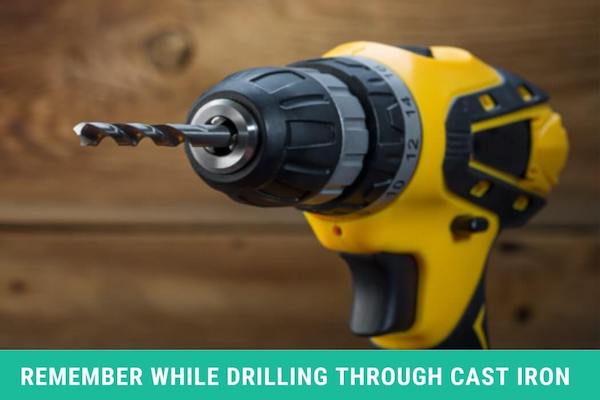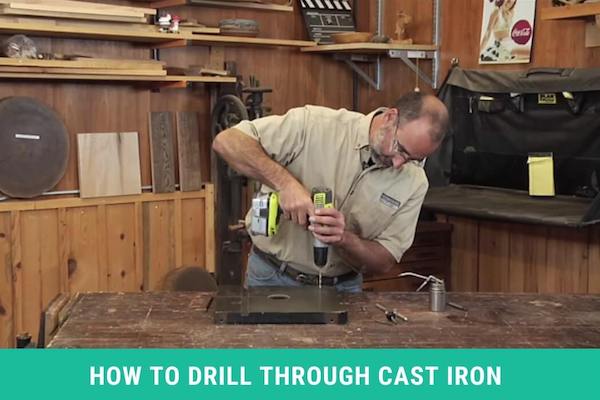Cast iron is a harder yet more brittle material that makes drilling a challenging task. But following the right process can lower the risk of cracking and offer a precise hole in the cast iron. So, learning how to drill through cast iron is the first step that can lead you through success.
Cast iron is a tough material that is used in plenty of applications. So often it needs to drill through cast iron to improve its functionality. But drilling a hole through it brings several challenges, including creaking the material, damaging the drill bit, and injuring the operator.
How to drill through cast iron- step by step
We have covered an effective and safe method of drilling through cast iron. Plus, the reader will learn some essential tips to ensure the precise and successful operation of cast iron.
Tools required:
- Drill machine
- A center punch and hammer
- Marker pen
The right drill bit
Nearly any drill bit can drill a hole through cast iron, including the best budget drill bit for cast iron. Usually, cast iron doesn’t resist the drill bit’s twisting motion, making it easier to drill. The only issue you may find is the debris.
So if you want to make the cast iron drilling process more convenient, go for the black oxide drill bit. These are sturdy and won’t let huge metal shavings get stuck in the hole once you complete the task. More importantly, it will cut through the cast iron without getting dull easily.
You can make the drilling easier and more precise by using a titanium nitride-coated drill bit. These are friction and heat resistance, making the drilling more comfortable. A cold cast can turn hot due to friction. So, using a TIN-coated drill bit will not only handle the issue but also offer six times longer than a typical drill bit for iron.
Protective gear
Undoubtedly, protective gear is important. Wear a pair of protective goggles to keep your eyes, ears, and temples safe. Pair of tough gloves that are made of leather or canvas are more preferable. These will prevent the drill from slipping and lower the potential danger. Don’t forget to wear a work jacket and denim jeans to keep your body from flying debris and other dangers. Other tools are required:
Prepare the tools
Start by preparing all the tools needed to drill through cast iron. Wear your protective gear and prepare for the drill. If you are using a cordless drill to drill through cast iron, check the battery to see if it is fully charged or not.
Conversely, check the power outlet close to the working area if a corded drill is in your hand. Lubricate the drill bit if you need to drill multiple holes through cast iron. However, it’s not required for drilling one or two holes. Check the lower section to deeply learn about lubricating.
Leave a notch on the working surface
It is ideal to mark the spot before starting drilling. It will help you land the drill bit in the exact spot to drill in the targeted area. So make a mark on the cast iron using a center punch and a hammer.
Attach the drill bit to the drill
Understand the size of the hole you intended through cast iron. Choose the right size drill bit based on the requirements. If you are planning to screw the hole, then use a slightly small drill bit to screw it. It will let the screw create a secure bond.
Secure the cast iron
If you want to drill through a loose piece of cast iron, then secure it first. Use a table with clamps to hold both sides of the cast iron securely. If it was previously attached to an immovable object, you can skip this step.
Start drilling slowly
Place the drill bit against the center mark, hold the drill upright and start pulling the trigger slowly. Using a smaller drill bit at the initial stage will reduce the chance of making a mistake. It recommended completing the task slowly yet precisely rather than messing up the entire thing.
Follow back and forth motion
Once you have created the hole, hold the trigger down and gradually pull the drill bit back. Maintain a back and forth motion to remove the metal debris successfully. Don’t excessively drill holes through cast iron. Take some time and let the power tool rest and calm the motor down.
Clear the working surface
If you have successfully drilled a hole, wipe down the surface with a dry cloth. Then clean the cast iron surface with a wet cloth and wipe it down with a dry fabric again. clean the inside of the hole even if you created a smaller hole. There can be metal debris that can prevent the screw from creating a secure bond.
Which is better for drilling through cast iron: lubricating or not lubricating?
Many professional enthusiasts recommend drilling through cast iron without lubricating it. Usually, cast iron contains high carbon content, which acts as a lubricant. So it doesn’t require applying lubricant separately. Despite this, the lubricant makes a mess and helps the debris stick to the drill bit rather than falling away.
Conversely, lubricants like water-based coolants and oil, lower the drill bit heat and prevent cracking. In conclusion, if you want to drill one or two holes through cast iron, you don’t need to apply lubricant to the drill bit. But if you need many holes, lubricating periodically will ensure successful operation and boost the drill bits’ longevity.
Some effective tips to remember while drilling through cast iron
Use extra cutting fluid: Using drill bits extensively can warm up the bit. So if you need to handle a large project, feel free to wipe away the debris often and apply a few oil drops.

A slower setting is better for starting: Higher speed settings create more friction which builds up heat. Conversely, slower speed allows drilling through cast iron without slippage and makes the best drill bit dull quickly. don’t exceed 3000 RPM, while less than 1000 RPM is more preferable.
Step bits are ideal for large hole: Multiple bits will be more helpful for drilling a large hole through cast iron. But if you use one, then doesn’t drill too quickly as it can damage the task.
Arrange an old rag: Make sure you have an old rag nearby while drilling the hole. You will have to clean up the extra cutting fluid and debris. Wiping up these metals on your pants and shirt can cause injury. So, using an old rag instead of your clothes will keep you safe.
Always create a mark: Indicating the drilling spot before powering on the drill will help you drill in the desired spot. It will boost confidence and ensure precise operation.
Check the width of the material: Use a ruler and a leveller to check the depth of the material. Drilling too far can damage anything around it.
Secure the material: Don’t drill into loose cast iron as it can cause injury. Vices can be a handy option if they’re a free piece of metal.
FAQs on How to drill through cast iron
What is the best drill bit for drilling through cast iron?
A cobalt drill bit with a 135-degree point angle is the best drill for applying to cast iron. Its angle is sharper than a typical drill bit, resulting in faster and more convenient drilling. Even gold-coloured titanium nitride bits are also preferable for drilling through cast iron.
Can I drill through a cast iron bathtub?
Some manufacturers confirm that their cast iron bathtubs can be drilled. However, it is better to skip drilling through a cast iron bathtub and use strong glue and silicone instead.
Is it easy to drill cast iron?
You can use any metal drill bit to drill through cast iron. It’s a more brittle material than others, which can be drilled easily. But it is recommended to start with a slower setting to prevent excess friction and overheating to drill through cast iron tub successfully.
Final words
Drilling and tapping cast iron are easier task and it doesn’t produce much debris. But it’s a brittle material. Once you have learned how to drill through cast iron properly, you can now handle the task efficiently. Follow those steps properly and enjoy using this tough and heat-resistance material for your home projects without worrying about drilling.
